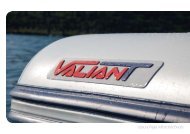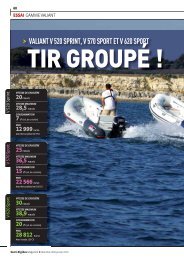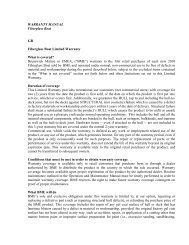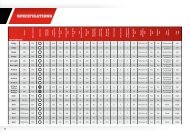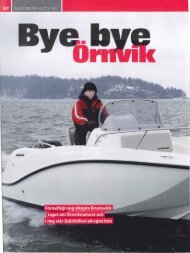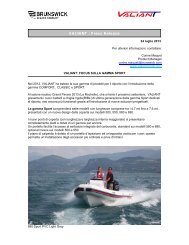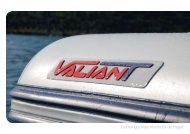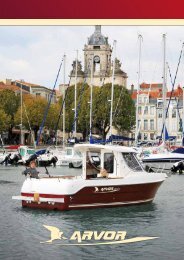899883192 - Valiant
899883192 - Valiant
899883192 - Valiant
You also want an ePaper? Increase the reach of your titles
YUMPU automatically turns print PDFs into web optimized ePapers that Google loves.
Section 3 - On the Water<br />
Keep in mind, one of the most important things you can do to help reduce injury or impact<br />
damage in these situations is control the boat speed. Boat speed should be kept to a<br />
minimum planing speed when driving in waters known to have underwater obstacles.<br />
After striking a submerged object, stop the engine as soon as possible and inspect the<br />
drive system for any broken or loose parts. If damage is present or suspected, the power<br />
package should be taken to an authorized Mercury MerCruiser dealer for a thorough<br />
inspection and necessary repair.<br />
The boat should be checked for hull fractures, transom fractures and water leaks.<br />
Operating with damaged underwater drive components, rudder or boat bottom could cause<br />
additional damage to other parts of the power package, or could affect control of the boat.<br />
If continued operation is necessary, do so at greatly reduced speeds.<br />
! WARNING<br />
Operating a boat or engine with impact damage can result in product damage, serious<br />
injury, or death. If the vessel experiences any form of impact, have an authorized Mercury<br />
Marine dealer inspect and repair the vessel or power package.<br />
Conditions Affecting Operation<br />
Weight Distribution (Passengers and Gear) Inside the Boat<br />
Shifting weight to rear (stern):<br />
• Generally increases speed and engine RPM<br />
• Causes bow to bounce in choppy water<br />
• Increases danger of following wave splashing into the boat when coming off plane<br />
• At extremes, can cause the boat to porpoise<br />
Shifting weight to front (bow):<br />
• Improves ease of planing<br />
• Improves rough water ride<br />
• At extremes, can cause the boat to veer back and forth (bow steer)<br />
The Bottom of the Boat<br />
Cavitation<br />
To maintain maximum speed, the boat bottom should be:<br />
• Clean, free of barnacles and marine growth<br />
• Free of distortion; nearly flat where it contacts the water<br />
• Straight and smooth, fore and aft<br />
Marine vegetation may accumulate when the boat is docked. This growth must be removed<br />
before operation; it may clog the water inlets and cause the engine to overheat.<br />
Cavitation occurs when water flow cannot follow the contour of a fast‐moving underwater<br />
object such as a gear housing or a propeller. Cavitation increases propeller speed while<br />
reducing boat speed. Cavitation can seriously erode the surface of the gear housing or the<br />
propeller. Common causes of cavitation are:<br />
• Weeds or other debris snagged on the propeller<br />
• Bent propeller blade<br />
• Raised burrs or sharp edges on the propeller<br />
Page 54 90-<strong>899883192</strong> NOVEMBER 2008




